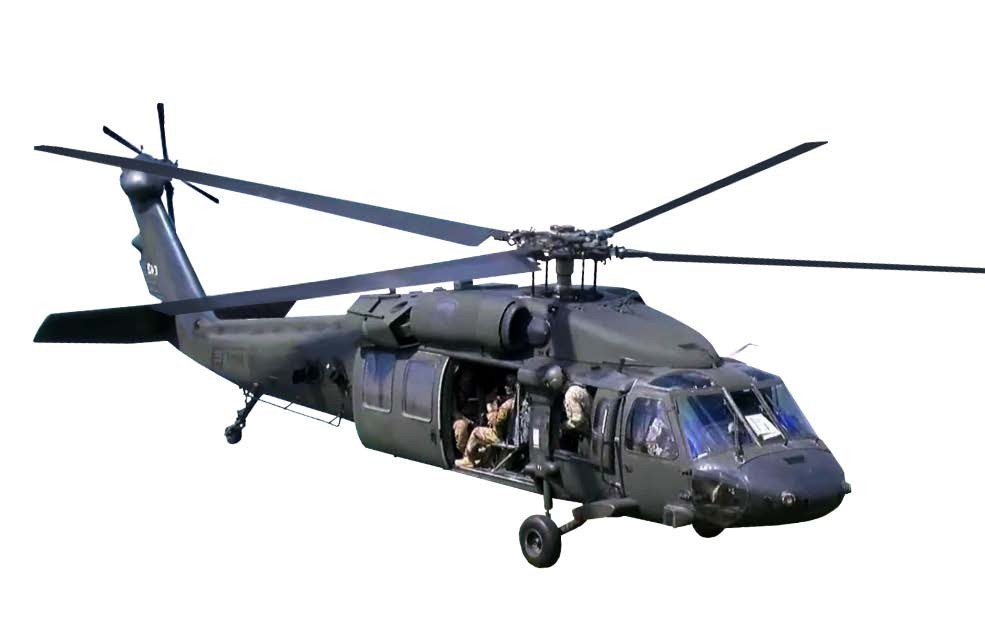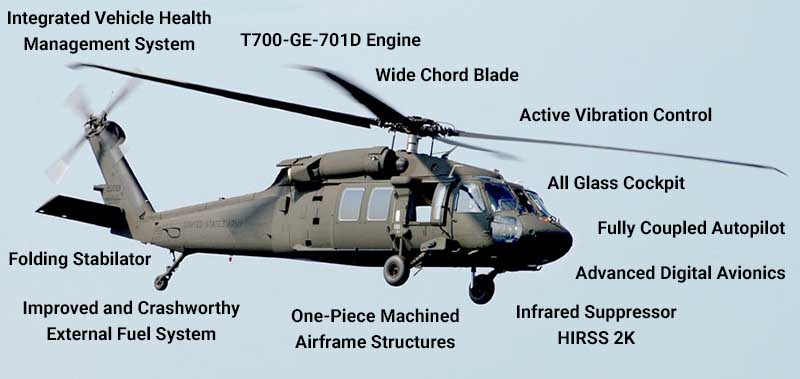UH-60: Developments in Modern Helicopter Design
The UH-60 helicopter stands as a benchmark in modern-day air travel, showcasing significant advancements in layout and innovation that accommodate the advancing demands of military procedures. Its consolidation of advanced products not only boosts efficiency but additionally addresses important safety issues. The integration of innovative avionics has changed operational capacities, allowing for better situational awareness and decision-making effectiveness. As we check out the evolution and crucial developments of the UH-60, it comes to be vital to take into consideration exactly how these growths influence not just current applications however additionally the future landscape of helicopter design.

Evolution of the UH-60
The advancement of the UH-60 Black Hawk helicopter stands for a significant landmark in aerospace design and military aeronautics. Presented in the late 1970s, the UH-60 was developed by Sikorsky Airplane to satisfy the United States Military's requirement for a versatile energy helicopter efficient in performing a range of missions. Its layout emphasized rate, maneuverability, and toughness, setting brand-new standards for functional efficiency.
The UH-60 features an unique four-blade blades system, which boosts lift and stability, enabling it to run efficiently in varied environments. Its airframe is built from advanced composite materials, adding to a decrease in weight while preserving architectural integrity. The helicopter's design likewise includes improved aerodynamics, which improves gas efficiency and enhances variety.
For many years, the Black Hawk has actually undergone several upgrades to improve its capacities, consisting of improved engines, advanced flight control systems, and modular systems for simple upkeep and flexibility. The helicopter's ability to do goals varying from army transportation to medical evacuation has solidified its role as a foundation of united state military operations. The UH-60 Black Hawk remains a prime example of exactly how advancement in helicopter style can dramatically influence army performance and functional versatility.
Advanced Avionics Equipments
Developments in avionics systems have actually changed the capacities of modern-day helicopters like the UH-60 Black Hawk, boosting functional efficiency and situational understanding (UH 60). The combination of advanced avionics enables enhanced navigation, communication, and flight administration, making the UH-60 much more versatile in diverse mission profiles
Among the vital functions is the sophisticated digital cabin, which utilizes multifunction displays that provide real-time information, making certain pilots have immediate accessibility to essential trip info. This streamlining of information decreases pilot workload and enhances decision-making procedures during complex procedures. In addition, the unification of GPS and inertial navigating systems allows precise positioning and course planning, improving objective execution in tough atmospheres.
Moreover, progressed avionics systems improve communication capacities through safe and secure data web links and voice communication systems, permitting seamless control with ground pressures and other airplane. The integration of automatic trip control systems even more adds to improved security and control, particularly in damaging weather or throughout low-altitude maneuvers.
Engine and Efficiency Enhancements
Engine efficiency in modern helicopters has taken a considerable jump ahead, driven by technologies that enhance power, reliability, and efficiency. The UH-60 Black Hawk, for instance, utilizes the T700-GE-701C engine, which includes a dual-channel, full-authority electronic engine control system.
In addition, the assimilation of engine wellness tracking systems permits for real-time diagnostics and anticipating maintenance, considerably enhancing operational integrity. These systems not just alert crews to potential concerns prior to they end up being vital yet likewise help with a lot more YOURURL.com effective maintenance scheduling, Website therefore minimizing downtime.

Materials and Structural Innovations
Recent developments in materials and structural design have reinvented modern-day helicopter building and construction, enhancing both efficiency and durability. The introduction of advanced composite products, such as carbon fiber enhanced polymers, has actually dramatically lowered weight while keeping structural integrity. This change not just boosts gas effectiveness but also increases payload ability, permitting helicopters like the UH-60 to do even more varied objectives.
Additionally, technologies in aluminum alloys and titanium components have actually contributed to enhanced resistance to deterioration and tiredness, prolonging the life expectancy of vital airframe elements. The critical use these products has actually led to a decrease in maintenance needs and enhanced total operational readiness.

In addition, the integration of computer-aided layout (CAD) and additive manufacturing innovations has actually allowed extra lightweight frameworks and complicated geometries, maximizing the aerodynamic performance of helicopter layouts. These advancements assist in quick prototyping and production, enabling suppliers to respond swiftly to progressing goal needs.
Security and Survivability Attributes
Security and survivability functions in contemporary helicopter design have ended up being critical, showing the enhancing demands for mission performance in tough settings. The UH-60 Black Hawk, a remarkable instance, integrates advanced technologies to boost staff and traveler security.
The helicopter also uses a ballistic defense system, which consists of useful site armored team seats and crucial systems protecting, decreasing vulnerability to tiny arms fire and shrapnel. Improved situational understanding is achieved via sophisticated avionics and sensor modern technologies, enabling pilots to spot and avoid threats effectively.
Additionally, the integration of redundancy in crucial systems-- such as dual engines and multiple trip control channels-- makes certain continued procedure even if one system fails. The UH-60 is equipped with innovative emergency flotation protection gadgets, enhancing survivability in water touchdowns. Jointly, these functions not just enhance the safety and security of workers yet likewise raise mission success prices in aggressive atmospheres, showing the commitment to quality in helicopter design.
Final Thought
The UH-60 helicopter represents a considerable improvement in modern-day aeronautics modern technology, incorporating innovative materials, advanced avionics, and robust security functions. In general, the UH-60 serves as a benchmark for future developments in helicopter design, embodying resilience and flexibility in contemporary military operations.
The UH-60 helicopter stands as a benchmark in modern aviation, showcasing significant improvements in layout and modern technology that provide to the progressing demands of military operations. As we explore the advancement and vital advancements of the UH-60, it ends up being vital to think about how these growths affect not just present applications but additionally the future landscape of helicopter layout.
Introduced in the late 1970s, the UH-60 was developed by Sikorsky Aircraft to fulfill the United States Army's need for a functional energy helicopter capable of performing a selection of missions. The UH-60 Black Hawk continues to be a prime instance of exactly how innovation in helicopter layout can substantially impact army performance and operational adaptability.
Generally, the UH-60 serves as a standard for future developments in helicopter layout, symbolizing resilience and convenience in contemporary army operations.
Comments on “Exploring the Versatility of the UH 60 in Different Armed Forces and Private Duties”